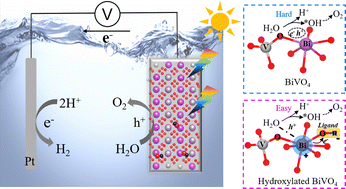Bismuth vanadate (BiVO4) is one of the most effective photoanode materials for photoelectrochemical water splitting, but its reaction rate is greatly limited by the poor separation efficiency of photo-generated charges and sluggish kinetics. In this work, a surface hydroxylation strategy was carried out to overcome the above-mentioned shortcomings. A simple post-synthetic NaOH immersion method was used to successfully hydroxylate the BiVO4 photoanode surface without affecting its bulk properties. The modified surface hydroxyl group not only promotes the photo-generated charge separation efficiency of hydroxylated BiVO4 but also tailors its local electronic structure to form high-valence Bi(3+x)+ states. The Bi(3+x)+ species serving as the active site is advantageous for water dissociation, thus decreasing the free energy barrier of the potential-determining step for the boosted overall water oxidation kinetics. As a result, the best hydroxylated BiVO4 photoanode achieves a higher photocurrent density of 1.14 mA cm−2 at 1.23 V vs. RHE under visible light irradiation, which is 4.75 times that of bare BiVO4 (0.24 mA cm−2), and moreover, a cathodic shift of 190 mV at 1 mA cm−2 is obtained. Our work affords a practical method with strong operability to improve the intrinsic photoelectrochemical performance of photoanodes by the efficient surface hydroxylation strategy.

